- Return to main Featured Ranch Archives index
Crooked Lake Ranch
March 2005
Central Florida was pounded by four major hurricanes last season and livestock producers, being the largest land holders, were adversely impacted. Trees got uprooted, tree limbs scattered everywhere, and flooding of pastureland from crested lakes and rivers diminished access to grazing. Barn roofs were blown off and pivot irrigation systems were broken into pieces.
To familiarize ourselves with the hurricane recovery effort by livestock producers in central Florida, Ivey Brantley, the new dynamic Extension Livestock Agent of Polk Co. and I visited the Crooked Lake Ranch on December 12, 2004.
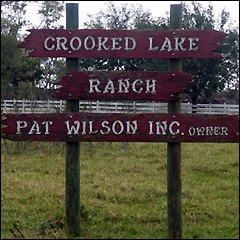
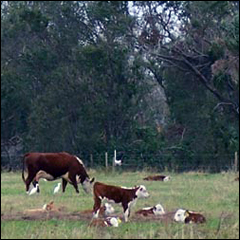
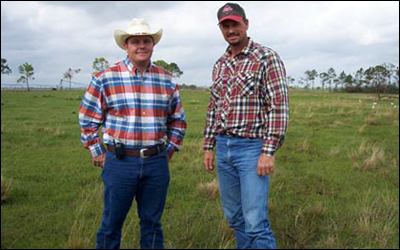
David McCullers, Ranch Manager (right) poses with Brantley Ivey during the visit.
Crooked Lake Ranch in Frostproof, FL, owned by Pat Wilson Inc, is an 1,100 acre ranch that has a unique breeding program. Primarily, the ranch is used to introduce genetics from the Hereford breed into the main ranch, Latt Maxcy Corp. David McCullers, the ranch manager, manipulates three different breeding programs to accomplish both genetic improvements to the main ranch as well as increase ranch profitability. The breeding program that David uses is categorized by A, B, and C.
The "A" segment of the breeding program includes purebred Hereford bred back to purebred Hereford. This is the portion of David's program that allows him to use the genetics of Crooked Lake Ranch and spread these better genetics to the larger scale Latt Maxcy Corp.
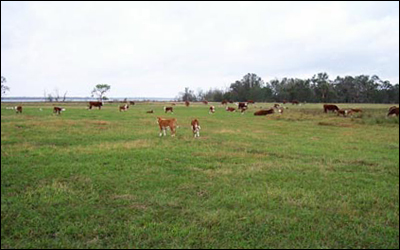
Purebred Herefords are bred back to Purebred Hereford in segment "A" of the breeding program.
The "B" leg of the system is using purebred Hereford females matched with a purebred Brahman bull to create an F-1 cross. By doing this David can still use the good genetics of his Hereford cattle as well as impart the desirable characteristics of the well adapted Brahman breed. Through this practice David is able to include an often overlooked characteristic, heterosis. Heterosis, or often times known as hybrid vigor, is an important tool used by cow/calf producers to improve growth in calves.
The third segment of David's breeding program utilizes the F-1's from the "B" leg with a third breed to develop a "composite" of sort. David sends calves from the A segment to the main ranch. David is a progressive manager and utilizes better management practice to ensure that Crooked Lake Ranch will continue to remain a viable part of Florida's cow/calf industry.
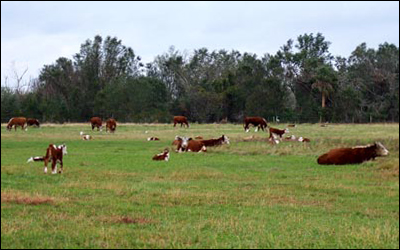
Herd of Hereford cows and calves.
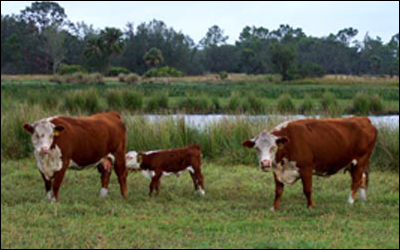
Hereford cows and calf on Crooked Lake Ranch.
To our pleasant surprise, the ranch was right on track to full recovery from Hurricane Charley when we paid our visit. All tree debris had been cleaned. The traveling pivot irrigation systems which were severely damaged by hurricanes had been replaced and operational.
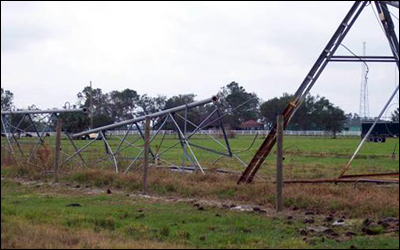
Pivot irrigation system damaged by Hurricane Charley August 13, 2004.
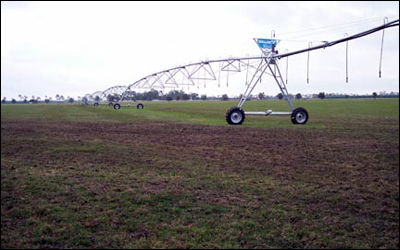
Newly installed pivot irrigation system following damage by hurricane Charley.
Planting of a tetraploid ryegrass variety (777 variety supplied by Wise seed Co., Frostproof) started on November 1 and continued through December during our visit. Because of the close proximity to the Crooked Lake, the ground was still wet at the time we visited so David was improvising successfully with a new planting method to beat time. This consisted of close mowing, followed by broadcasting the seed before covering with a pasture aerator and a roller to pack the soil.
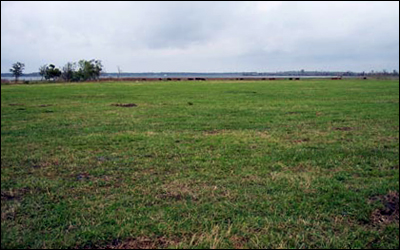
Proximity of ranch to Crooked Lake caused serious flooding during the 2004 hurricanes.
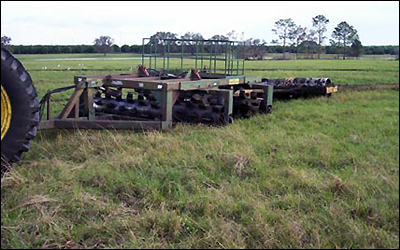
Pulled together, a double-roller aerator and roller behind, incorporate ryegrass seed and firm ground in one operation.
One such ryegrass field that had been planted on November 1 was growing nicely and expected to be ready for grazing on Jan 1 through April, just before bahiagrass pastures kicked in. The fertilizer program for ryegrass on the ranch consists of 300 lb/A of 18-18-18 (N-P2O5-K2O) followed by 55 lb/A of N from ammonium nitrate.
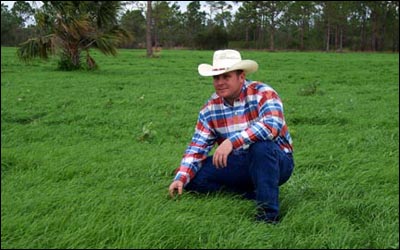
Planted on November 1, 2004, this ryegrass field was ready for grazing on January 1, 2005.
Besides bahiagrass pastures, several varieties of perennial warm season grasses are managed under irrigation for hay on the ranch. Pangolagrass of old, Floralta Limpograss and the new Mulatograss were part of the diversification of forage program on Crooked Lake Ranch. David had established 15 acres of Mulatograss in 2004 and plans to expand it to 45 acres this year. He remarked, "Armyworms, grasshoppers and mole crickets eat up bahiagrass but not Mulatograss and the palatability of Mulatograss to cattle is incredible".
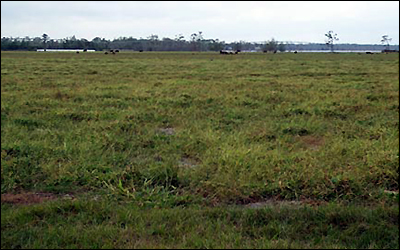
Mulato grass stand in the foreground.
David was busy with planting ryegrass during our visit, hence, after a brief discussion with him, Ivey and I spent the greater part of that morning driving around and taking pictures. We share those shots with you to portray how advanced their hurricane remediation had gone in just four months and the level of diversification in the ranching operation on the property.
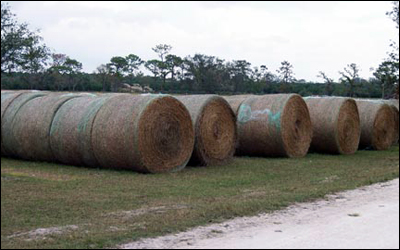
Ranch income includes the sale of round bales of Pangola hay.
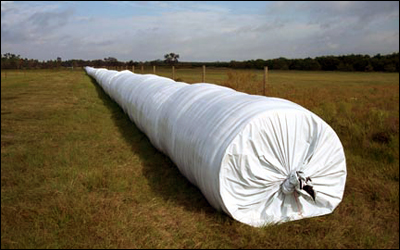
Haylage preserved in tubes is used to supplement winter grazing.

